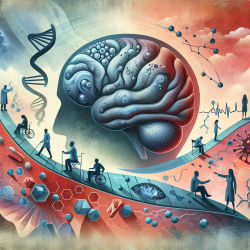Introduction
Neuroferritinopathy (NF) is a rare, autosomal dominant disorder characterized by abnormal iron accumulation in the brain, primarily affecting the basal ganglia. This condition is caused by mutations in the ferritin light chain 1 (FTL1) gene. As a progressive movement disorder, NF presents with a variety of symptoms, making it a challenge for practitioners to diagnose and manage effectively. This blog aims to provide insights into the pathophysiology, clinical presentation, differential diagnoses, and management strategies for NF, encouraging practitioners to enhance their skills and knowledge in this area.
Pathophysiology
The brain requires iron for essential functions, including oxygen transport, energy generation, and neurotransmitter production. In NF, mutations in the FTL1 gene lead to pathological iron deposition and ferritin inclusions in the brain. This results in oxidative stress and cellular damage, contributing to the neurodegenerative process. Understanding these mechanisms is crucial for practitioners to comprehend the disease's progression and impact on patients.
Clinical Presentation
NF typically presents in adulthood with a range of movement disorders, including chorea, dystonia, and parkinsonism. The clinical manifestations can vary significantly among patients, influenced by the specific genetic mutation and other factors. Practitioners should be aware of these variations to accurately diagnose and manage the condition. A strong family history and imaging evidence of iron deposition in the brain can aid in the diagnosis.
Differential Diagnoses
Given the diverse clinical presentations of NF, it is essential for practitioners to consider a range of differential diagnoses. These may include Huntington's disease, Wilson's disease, and other neurodegenerative disorders with brain iron accumulation. A thorough understanding of these conditions and their distinguishing features can help practitioners make informed diagnostic decisions.
Management Strategies
Currently, there is no disease-specific treatment for NF. Management focuses on symptomatic relief, with variable success. Practitioners may use a combination of medications, such as anticholinergics, dopamine-depleting agents, and benzodiazepines, to address movement disorders. Additionally, physiotherapy and speech therapy can support patients in maintaining mobility and communication abilities.
Iron-modulating therapies, including chelation and dietary interventions, have not shown significant benefits in NF. Practitioners should remain updated on emerging research and potential treatment options to provide the best care for their patients.
Conclusion
Neuroferritinopathy presents unique challenges for practitioners due to its rare nature and complex clinical presentation. By understanding the underlying pathophysiology, recognizing the diverse symptoms, and considering appropriate differential diagnoses, practitioners can improve their diagnostic and management skills. Ongoing research and collaboration among healthcare professionals are essential to advancing our knowledge and treatment of this condition.
To read the original research paper, please follow this link: Neuroferritinopathy: Pathophysiology, Presentation, Differential Diagnoses and Management.










